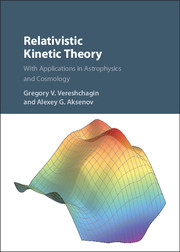Book contents
- Frontmatter
- Contents
- Preface
- Acknowledgments
- Acronyms and Definitions
- Introduction
- Part I Theoretical Foundations
- Part II Numerical Methods
- 7 The Basics of Computational Physics
- 8 Direct Integration of Boltzmann Equations
- 9 Multidimensional Hydrodynamics
- Part III Applications
- Appendix A Hydrodynamic Equations in Orthogonal Curvilinear Coordinates
- Appendix B Collision Integrals in Electron-Positron Plasma
- Appendix C Collision Integrals for Weak Interactions
- Bibliography
- Index
8 - Direct Integration of Boltzmann Equations
from Part II - Numerical Methods
Published online by Cambridge University Press: 09 March 2017
- Frontmatter
- Contents
- Preface
- Acknowledgments
- Acronyms and Definitions
- Introduction
- Part I Theoretical Foundations
- Part II Numerical Methods
- 7 The Basics of Computational Physics
- 8 Direct Integration of Boltzmann Equations
- 9 Multidimensional Hydrodynamics
- Part III Applications
- Appendix A Hydrodynamic Equations in Orthogonal Curvilinear Coordinates
- Appendix B Collision Integrals in Electron-Positron Plasma
- Appendix C Collision Integrals for Weak Interactions
- Bibliography
- Index
Summary
In this chapter, our experience of the integration of Boltzmann equations by the finite difference method is presented. In spherically symmetric geometry the approach operates with finite differences on the fixed grid in 4D phase space for particles (r, μ, ϵ, t), and it is based on the method of lines. The ODE system is solved by implicit Gear's method suitable for integration of stiff equations. The method takes into account all reactions and is applicable to both optically thick and optically thin regions. This chapter also includes description of Monte Carlo (MC) methods for integration of the Boltzmann equation. For small and moderate optical depth, MC is a universal approach able to describe different reactions and is especially suitable for multidimensional geometry. It is shown how the linear MC method is extended for large optical depths with simple reaction rates such as in Compton scattering.
Finite Differences and the Method of Lines
This section is limited to 1D spatial geometry (spherically symmetric case) with full physical processes and implicit methods.
A large number of physical problems requires solution of Boltzmann equations. Analytical solutions are available in exceptional cases, and in the general case one should rely on effective numerical integration. As discussed in the previous chapter, the finite difference technique [117] represents one such effective method.
Finite differences are widely employed in astrophysical problems. Specific examples, considered in Part III, include thermalization of nonequilibrium optically thick electron-positron plasma and neutrino transport in the core collapse supernovae.
Finite differences for the kinetic equation in astrophysical applications were introduced in [118]. In particular, in the gravitational collapse of the iron core of a massive star to a neutron star, neutrinos play a crucial role. Neutrino transport should be described by Boltzmann equations. The core on the verge of collapse has the radius 108 cm, and it is transparent for neutrinos. The collapsed hot proto-neutron star has a radius of 106–107 cm, and neutrinos are trapped with the optical depth. It is impossible to treat such problems by explicit methods due to the presence of different timescales characterizing different processes.
- Type
- Chapter
- Information
- Relativistic Kinetic TheoryWith Applications in Astrophysics and Cosmology, pp. 95 - 105Publisher: Cambridge University PressPrint publication year: 2017



